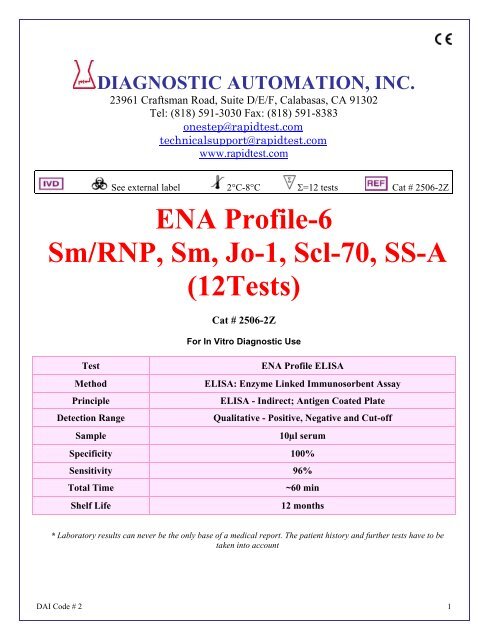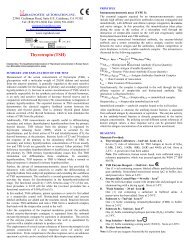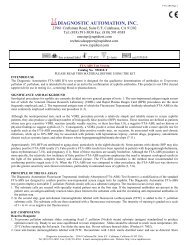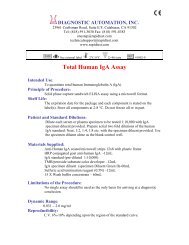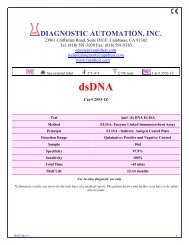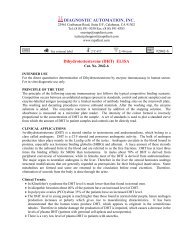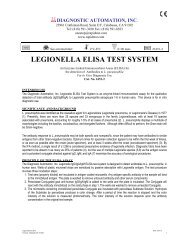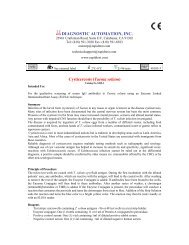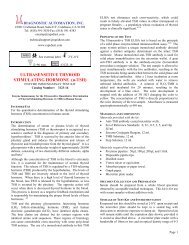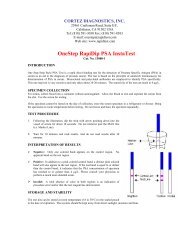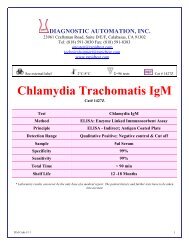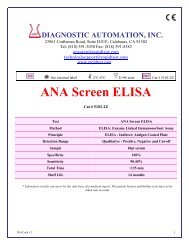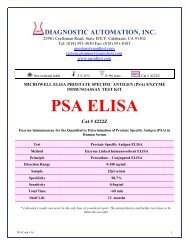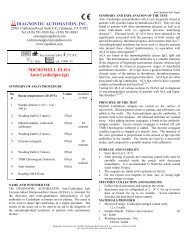ENA Profile - Diagnostic Automation : Cortez Diagnostics
ENA Profile - Diagnostic Automation : Cortez Diagnostics
ENA Profile - Diagnostic Automation : Cortez Diagnostics
You also want an ePaper? Increase the reach of your titles
YUMPU automatically turns print PDFs into web optimized ePapers that Google loves.
PRINCIPLE OF THE ELISA ASSAYThe DAI. <strong>ENA</strong> <strong>Profile</strong>-6 ELISA test system is designed to detect IgG class antibodies to differentautoantigens in human sera. Wells of plastic microwell strips are sensitized by passive absorption withimmobilized antigens. The test procedure involves three incubation steps:1. Test sera (properly diluted) are incubated in antigen coated microwells. Any antigen specific antibodyin the sample will bind to the immobilized antigen. The plate is washed to remove unbound antibodyand other serum components.Peroxidase Conjugated goat anti-human IgG (γ chain specific) is addedto the wells and the plate is incubated. The Conjugate will react with the antibodies immobilized onthe solid phase in step 1. The wells are washed to remove unreacted Conjugate.2. The microwells containing immobilized peroxidase Conjugate are incubated with peroxidaseSubstrate Solution. Hydrolysis of the Substrate by peroxidase produces a color change. After a periodof time the reaction is stopped and the color intensity of the solution is measured photometrically. Thecolor intensity of the solution depends upon the antibody concentration in the original test sample.MATERIALS PROVIDEDEach kit contains the following components in sufficient quantities to perform the number of testsindicated on packaging label. Note: All reactive reagents contain sodium azide as a preservative at aconcentration of 0.1% (w/v).The following components are not kit lot number dependent and may be used interchangeably with theELISA assays: TMB, Stop Solution, and Wash Buffer.Note: Kit also contains:1. Component list containing lot specific information is inside the kit box.2. Package insert providing instructions for use.DAI Code # 2 3
MATERIALS REQUIRED BUT NOT PROVIDED:• ELISA microwell reader capable of reading at a wavelength of 450nm.• Pipettes capable of accurately delivering 10 to 200µL.• Multichannel pipette capable of accurately delivering (50-200µL)• Reagent reservoirs for multichannel pipettes.• Wash bottle or microwell washing system.• Distilled or deionized water.• One liter graduated cylinder.• Serological pipettes.• Disposable pipette tips.• Paper towels.• Laboratory timer to monitor incubation steps.• Disposal basin and disinfectant. (example: 10% household bleach, 0.5% sodium hypochlorite.)STORAGE CONDITIONS1. Store the unopened kit between 2° and 8°C.2. Coated microwell strips: Store between 2° and 8°C. Extra strips should be immediately resealed withdesiccant and returned to proper storage. Strips are stable for 60 days after the envelope has beenopened and properly resealed and the indicator strip on the desiccant pouch remains blue.3. Conjugate: Store between 2° and 8°C. DO NOT FREEZE.4. Positive Control and Negative Control: Store between 2° and 8°C.5. Human Calibrator: Store between 2º and 8ºC. Following reconstitution, stable for 30 days between2º and 8ºC.6. TMB: Store between 2° and 8°C.7. Wash Buffer concentrate (10X): Store between 2° and 25°C. Diluted wash buffer (1X) is stable atroom temperature (20° to 25° C) for up to 7 days or for 30 days between 2° and 8°C.8. Sample Diluent: Store between 2° and 8°C.9. Stop Solution: Store between 2° and 25°C.SPECIMEN COLLECTION1. It is recommended that specimen collection be carried out in accordance with NCCLS document M29:Protection of Laboratory Workers from Infectious Disease.2. No known test method can offer complete assurance that human blood samples will not transmitinfection. Therefore, all blood derivatives should be considered potentially infectious.3. Only freshly drawn and properly refrigerated sera obtained by approved aseptic venipunctureprocedures should be used in this assay (17, 18). No anticoagulants or preservatives should beadded. Avoid using hemolyzed, lipemic, or bacterially contaminated sera.4. Store sample at room temperature for no longer than 8 hours. If testing is not performed within 8hours, sera may be stored between 2° and 8°C for no longer than 48 hours. If delay in testing isanticipated, store test sera at –20°C or lower. Avoid multiple freeze/thaw cycles that may cause lossof antibody activity and give erroneous results.PREPARATION OF REAGENTS1. Wash Buffer: Dilute the 100mL of 10X concentrate with 900mL of distilled or deionized water. Mixthoroughly to dissolve any crystals that may be present.2. Human Calibrator: Reconstitute the contents of the vial with 1.0mL distilled or deionized water. Afterreconstitution the Calibrator is ready to use. Do not dilute additionally before use. Store unusedreconstituted Calibrator at 2-8ºC for no longer than 30 days.3. Sample Diluent, Conjugate, Substrate Solution, and Stop Solution are ready to use.DAI Code # 2 4
TEST PROCEDURESet-up of the AssayRemove the individual kit components and allow them to warm to room temperature (20-25ºC).Determine the total number of samples and controls to be tested. Each specimen will require one, 1x8profile antigen strip. The positive control, negative control, and calibrator must be included each time theassay is run. After the strips and holder have warmed to room temperature, cut open the protectiveenvelope and remove the plate containing the antigen coated microwell strips. Strips that are not neededfor the assay should be placed into the re-sealable pouch, sealed and returned to storage at 2-8ºC.Serum IncubationNOTE: After reconstitution, the calibrator is ready to use. Do not dilute.Prepare a 1:21 dilution of the positive and negative controls, and each patient serum as follows:1. Add 50µL of each sample, the positive control, and the negative control to a separate tube. Add1000µL of sample diluent to each tube. Mix the contents of each tube thoroughly. The sample diluentwill undergo a color change confirming that the specimen has been combined with the diluent.2. Add 100µL of sample diluent to every well in row A.3. Using a multichannel pipette, load the controls, calibrator, and patient specimens as outlined below.Load 100µL per well. The reconstituted calibrator is ready to load, do not dilute.Column Number:Antigen: Row: 1 2 3 4 5 ETC.Ag Mixture A Dil Dil Dil Dil DilJo-1 B NC PC Cal Test 1 Test 2Sm C NC PC Cal Test 1 Test 2Sm/RNP D NC PC Cal Test 1 Test 2SSA E NC PC Cal Test 1 Test 2SSB F NC PC Cal Test 1 Test 2Scl-70 G NC PC Cal Test 1 Test 2Control Ag H NC PC Cal Test 1 Test 24. Cover the wells with a plate sealer and incubate the plate at room temperature (20-25ºC) for 25 ± 5minutes.5. Wash the microwell strips 5X.a. Vigorously shake out the liquid from the wells.b. Fill each well with wash buffer. Make sure no air bubbles are trapped in the wells.c. Repeat steps a. and b. for a total of five washes.d. Shake out the wash solution from all the wells. Invert the plate over a paper towel and tap firmlyto remove any residual wash solution from the wells. Visually inspect the plate to ensure that noresidual wash solution remains. Collect wash solution in a disposable basin and treat with 0.5%sodium hypochlorite (10% household bleach) at the end of the days run.NOTE: Autowash - If using an automated wash system, set the dispensing volume to 300-350 µL/well.Set the wash cycle for 5 washes with no delay between washes. Remove microtiter plate from washer,invert plate over paper towel and tap firmly to remove any residual wash solution from the wells.Conjugate Incubation1. Add 100µL of the Conjugate solution to each well at the same rate and in the same order as thespecimens were added.2. Microwells may be covered to minimize evaporation. Incubate the plate at room temperature(20-25°C) for 25 ± 5 minutes.3. Wash the microwells by following the procedure as previously described.Substrate Incubation1. Add 100µL of the TMB substrate solution to each well at the same rate and in the same order as theconjugate was added. (1mL of TMB substrate is sufficient for 8 wells).DAI Code # 2 5
2. Incubate the plate at room temperature (20-25ºC) for 10-15 minutes.3. Add 50µL of stop solution to each well at the same rate and in the same order as the TMB solutionwas added. Positive samples will turn from blue to yellow. After adding stop solution, tap plate severaltimes to ensure that the samples are thoroughly mixed.4. Set the microplate reader wavelength at 450nm and measure the optical density (OD) of each well.The plate should be read within 30 minutes after the addition of the stop solution.CALCULATIONS/REPORTING RESULTSA. CALCULATION1. Determining Autoantigen-Specific Optical Density (OD):Controls, calibrator, and test specimens are all loaded on the control antigen well (Row H). The controlantigen well is prepared by coating and blocking the plastic with solutions which do not contain anyautoantigens. Therefore, the control antigen well provides measurement of non-specific absorbency ineach sample. Autoantigen-specific absorbency may be represented as the difference in optical densitybetween the antigen coated well and the control antigen well.Example:Test Specimen A, Control Well OD (Row H) = 0.175Test Specimen A, SSB Well OD (Row F) = 1.563SSB Specific OD = 1.563 - 0.175 = 1.388Using the respective control antigen well for each calibrator, control, and sample, determine theautoantigen-specific OD for each autoantigen. Do not subtract the control antigen OD from the conjugatecontrol well OD.2. CalibratorBased upon testing of normal and disease-state specimens, a maximum normal autoantibody unit (AAU)value has been determined by Zeus Scientific, Inc. and correlated to the calibrator. The calibrator willallow you to determine the unit value of test samples for each of the autoantigens, and to correct forslight day-to-day variations in test results. The unit value (CV) is determined for each autoantibodyantigen for each lot of kit components and is printed on the Component List.3. Conversion of Optical Density to AAU/mL:The conversion of autoantigen-specific OD to unit value (AAU/mL) can be represented by the followingequation:Test Specimen AAU/mL = (A x B)/CWhere:AAU/mL = Unknown unit value to be determinedA = OD of test specimen in question.B = Unit value of calibrator for autoantigen in question (AAU/mL).C = OD of calibrator.Example:Test specimen specific OD for SSA = 0.946Calibrator specific OD for SSA = 0.435Calibrator unit value for SSA = 155 AAU/mLTest Specimen AAU/mL = (0.946 x 155)/0.435Test Specimen = 337 AAU/mL for anti-SSAB. QUALITY CONTROL1. Each time the assay is run, the positive control, negative control, and calibrator must be included. Foreach profile strip, it is necessary to include a diluent blank (Row A), and a control antigen blank (RowH). The diluent blank measures the nonspecific interaction between the conjugate and theautoantigens. The control antigen well provides a measurement of non-specific interaction betweenpatient antibody and a control antigen.DAI Code # 2 6
2. Refer to the Component List included with each kit. This sheet describes the lot specific specificationsfor the calibrator. If the calibrator is out of range, the results are considered invalid, and patient resultsmay not be reported.3. The positive and negative control must meet the following specifications:Positive Control must be > 180 AAU/mLNegative Control must be < 150 AAU/mLPositive Control/Negative Control must be > 2.00.If the assay controls do not meet the above specifications, then the assay is considered invalid, andthe patient results may not be reported.4. Calculate the mean of the conjugate control wells (Row A). This value should be less than 0.200. Ahigh mean OD for the conjugate control could indicate inadequate washing, poor water quality, orcontaminated reagents. Variability from well-to-well indicates poor pipetting and/or inconsistency ofwashing, well-to-well.C. INTERPRETATION OF RESULTSUsing 152 normal healthy donor specimens, and 185 disease-state specimens, Zeus Scientific, Inc. hasestablished the following guidelines for the interpretation of patient results: 180 AAU/mL -PositiveUse the above guidelines when evaluating or interpreting patient specimens. Equivocal specimensshould be repeated. Specimens which are repeatedly equivocal should be evaluated using an alternateserological method. Elevated autoantibody levels to any of the profile autoantigens may be indicative of aspecific rheumatic disorder. The SIGNIFICANCE AND BACKGROUND section of this package insertdescribes some of the more common diseases associated with elevated autoantibody levels.NOTE: When interpreting the anti-Sm/RNP result to determine potential anti-RNP (only) activity, onemust consider the anti-Sm and the anti-Sm/RNP result simultaneously.For example, below are three likely scenarios:A. Anti-Sm result = 80, and anti-Sm/RNP result = 986 AAU/mL. Patient expresses a significant amountof anti-RNP.B. Anti-Sm result = 493 AAU/mL, and anti-Sm/RNP result = 1139 AAU/mL. Patient expresses significantamounts of both autoantibodies.C. Anti-Sm result = 37 AAU/mL, and anti-Sm/RNP result = 63 AAU/mL. Patient is negative for bothautoantibodies.PROCEDURE NOTESFor In Vitro <strong>Diagnostic</strong> Use1. Normal precautions exercised in handling laboratory reagents should be followed. In case of contactwith eyes, rinse immediately with plenty of water and seek medical advice. Wear suitable protectiveclothing, gloves, and eye/face protection. Do not breathe vapor. Dispose of waste observing all local,state, and federal laws.2. The wells of the ELISA plate do not contain viable organisms. However, the strips should beconsidered POTENTIALLY BIOHAZARDOUS MATERIALS and handled accordingly.3. The human serum controls are POTENTIALLY BIOHAZARDOUS MATERIALS. Source materialsfrom which these products were derived were found negative for HIV-1 antigen, HBsAg. and forantibodies against HCV and HIV by approved test methods. However, since no test method can offercomplete assurance that infectious agents are absent, these products should be handled at theBiosafety Level 2 as recommended for any potentially infectious human serum or blood specimen inthe Centers for Disease Control/National Institutes of Health manual “Biosafety in Microbiological andDAI Code # 2 7
Biomedical Laboratories”: current edition; and OSHA’s Standard for Bloodborne Pathogens (20).4. Adherence to the specified time and temperature of incubations is essential for accurate results. Allreagents must be allowed to reach room temperature (20-25°C) before starting the assay. Returnunused reagents to refrigerated temperature immediately after use.5. Improper washing could cause false positive or false negative results. Be sure to minimize theamount of any residual wash solution; (e.g., by blotting or aspiration) before adding Conjugate orSubstrate. Do not allow the wells to dry out between incubations.6. The diluent, controls, wash buffer, and conjugate contain sodium azide at a concentration of 0.1%(w/v). Sodium azide has been reported to form lead or copper azides in laboratory plumbing whichmay cause explosions on hammering. To prevent, rinse sink thoroughly with water after disposing ofsolution containing sodium azide.7. The Stop Solution is TOXIC. Causes burns. Toxic by inhalation, in contact with skin and if swallowed.In case of accident or if you feel unwell, seek medical advice immediately.8. The TMB Solution is HARMFUL. Irritating to eyes, respiratory system and skin.9. The Wash Buffer concentrate is an IRRITANT. Irritating to eyes, respiratory system and skin.10. Wipe bottom of plate free of residual liquid and/or fingerprints that can alter optical density (OD)readings.11. Dilution or adulteration of these reagents may generate erroneous results.12. Reagents from other sources or manufacturers should not be used.13. TMB Solution should be colorless, very pale yellow, very pale green, or very pale blue when used.Contamination of the TMB with conjugate or other oxidants will cause the solution to change colorprematurely. Do not use the TMB if it is noticeably blue in color.14. Never pipette by mouth. Avoid contact of reagents and patient specimens with skin and mucousmembranes.15. Avoid microbial contamination of reagents. Incorrect results may occur.16. Cross contamination of reagents and/or samples could cause erroneous results.17. Reusable glassware must be washed and thoroughly rinsed free of all detergents.18. Avoid splashing or generation of aerosols.19. Do not expose reagents to strong light during storage or incubation.20. Allowing the microwell strips and holder to equilibrate to room temperature prior to opening theprotective envelope will protect the wells from condensation.21. Wash solution should be collected in a disposal basin. Treat the waste solution with 10% householdbleach (0.5% sodium hypochlorite). Avoid exposure of reagents to bleach fumes.22. Caution: Liquid waste at acid pH should be neutralized before adding to bleach solution.23. Do not use ELISA plate if the indicator strip on the desiccant pouch has turned from blue to pink.24. Do not allow the conjugate to come in contact with containers or instruments that may havepreviously contained a solution utilizing sodium azide as a preservative. Residual amounts of sodiumazide may destroy the conjugate’s enzymatic activity.25. Do not expose any of the reactive reagents to bleach-containing solutions or to any strong odors frombleach-containing solutions. Trace amounts of bleach (sodium hypochlorite) may destroy thebiological activity of many of the reactive reagents within this kit.LIMITATION OF THE ASSAY1. A diagnosis should not be made solely on the basis of the <strong>ENA</strong> <strong>Profile</strong>-6 ELISA test results.2. Test results should be interpreted in conjunction with the clinical evaluation and the results of otherdiagnostic procedures.EXPECTED VALUESThe expected value for a normal patient is a negative result. The number of reactives, and the degree ofreactivity is dependent upon parameters such as population type being tested, treatment, etc. Eachlaboratory should establish their own expected values based upon the specimens typically being tested.With respect to disease-state and percent reactivity, Table 1 in the SIGNIFICANCE AND BACKGROUNDsection of this package insert shows the relative frequency of autoantibody activity for various rheumaticdisorders.DAI Code # 2 8
PERFORMANCE CHARACTERISTICSComparative Study:A comparative study was performed to demonstrate the equivalence of the DAI. <strong>ENA</strong> <strong>Profile</strong>-6 ELISA toseveral other commercially available autoantibody ELISA test systems. The performance of the <strong>ENA</strong><strong>Profile</strong>-6 ELISA was evaluated using 337* serum specimens; 152 normal donor samples from thenortheastern and southeastern United States, and 185 disease-state repository samples previouslycharacterized with respect to autoantibody activity. The results of the investigation have beensummarized in Tables 1 and 2 below:* The total population tested for anti-Jo-1 was 126; 64 normal donor samples, and 62 of the disease-staterepository samples.Table 1: Relative Sensitivity; Disease-State SpecimensAutoantigen A B C D SensitivityJo-1 8 8 0 8 8/8 = 100.0%Sm 13 16 3 13 13/13 = 100.0%Sm/RNP 46 58 11 50 46/50 = 92.0%SSA 56 74 18 57 56/57 = 98.2%SSB 28 34 6 29 28/29 = 96.6%Scl-70 8 17 9 8 8/8 = 100.0%A - Number of specimens reactive on DAI. Test System.B - Number of specimens reactive on Commercial ELISA Test System.C -D -Number of discrepant specimens.Number of positive specimens in the population after resolution of the discrepant specimens usingalternate methodology such as gel immunodiffusion (GID), IFA, and third-party ELISA tests.Table 2: Relative Specificity, Normal Donor SpecimensAutoantigen E F G H SpecificityJo-1 64 64 0 64 64/64 = 100.0%Sm 136 137 1 137 136/137 = 99.3%Sm/RNP 141 144 3 144 141/144 = 97.9%SSA 146 146 0 146 146/146 = 100.0%SSB 147 147 0 147 147/147 = 100.0%Scl-70 151 151 0 151 151/151 = 100.0%E - Number of specimens non-reactive on DAI. Test System.F - Number of specimens non-reactive on Commercial ELISA Test System.G -H -Number of discrepant specimens.Number of non-reactive specimens in the population after resolution of the discrepant specimensusing alternate methodology such as gel immunodiffusion (GID), IFA, and third-party ELISA tests.REPRODUCIBILITYTo assess the intra-assay and inter-assay variability of the test procedure, a strong positive, a lowpositive, and a negative sample for all of the autoantigens were tested eleven times on each of threedays. The mean unit value, the standard deviation, and the percent CV were calculated for each sample.The results of this study are depicted in Tables 3 - 6 below:DAI Code # 2 9
Table 3: Intra-Assay Reproducibility, ‘’High Positive’’ Specimen: DAI. <strong>ENA</strong> <strong>Profile</strong>-6 IgG ELISADay 1 Day 2 Day 3Antigen Mean SD %CV Mean SD %CV Mean SD %CVJo-1 459 15 3 391 22 6 385 18 5Sm 576 71 12 690 71 10 702 29 4Sm/RNP 535 73 14 426 73 17 608 76 12SSA 818 62 7 652 68 10 779 52 7SSB 1022 120 12 881 65 7 987 67 7Scl-70 669 95 14 626 65 10 726 93 3Table 4: Intra-Assay Reproducibility, ‘’Low Positive Specimen; DAI. <strong>ENA</strong> <strong>Profile</strong>-6 IgG ELISADay 1 Day 2 Day 3Antigen Mean SD %CV Mean SD %CV Mean SD %CVJo-1 232 11 5 189 9 4 189 8 4Sm 460 43 9 587 52 9 392 28 7Sm/RNP 184 34 18 246 34 14 216 29 13SSA 199 26 13 231 38 17 189 22 12SSB 178 29 16 167 20 12 210 25 12Scl-70 231 21 9 214 10 5 270 21 8Table 5: Intra-Assay Reproducibility, Negative Specimen; DAI. <strong>ENA</strong> <strong>Profile</strong>-6 IgG ELISADay 1 Day 2 Day 3Antigen Mean SD %CV Mean SD %CV Mean SD %CVJo-1 5 2 N/A 5 1 N/A 4 1 N/ASm 12 3 N/A 8 3 N/A 7 1 N/ASm/RNP 26 4 N/A 29 9 N/A 22 6 N/ASSA 27 4 N/A 14 6 N/A 13 5 N/ASSB 2 2 N/A 1 1 N/A 1 1 N/AScl-70 5 2 N/A 5 3 N/A 3 2 NA/Table 6: Intra-Assay Reproducibility; DAI. <strong>ENA</strong> <strong>Profile</strong>-6 <strong>ENA</strong> ELISADay 1 Day 2 Day 3Antigen Mean SD %CV Mean SD %CV Mean SD %CVJo-1 412 38 9 203 23 11 5 2 N/ASm 656 85 13 479 93 19 9 3 N/ASm/RNP 532 97 18 216 42 19 26 7 N/ASSA 750 95 13 207 35 17 18 9 N/ASSB 963 108 11 185 32 17 1 1 N/AScl-70 674 97 14 238 30 13 5 2 N/ACROSS REACTIVITYSpecimens negative for ANA by HEp-2 IFA and positive for IgG antibody to various antigens such asEBV-VCA, EBNA, HSV-1, HSV-2, CMV, Rubella, and/or Toxo, were tested for potential cross-reactivityusing the DAI. <strong>ENA</strong> <strong>Profile</strong>-6 ELISA Test System. All specimens tested were negative on the ELISA,indicating that the potential for cross reactivity with such antibodies is not likely, and therefore, should notinterfere with the results obtained.REFERENCES1. Tan E, Cohen A, Fries J, et al: Special Article: The 1982 revised criteria for classification of systemic lupus erythematosus.Arthritis Rheum. 25:1271-1277, 1982.DAI Code # 2 10
2. Beufels M, Kouki F, Mignon F, et al: Clinical significance of anti-Sm antibodies in systemic lupus erythematosus. Am. J.Med. 74:201-215, 1983.3. Sharp GC, Irwin WS, Tan EM, Holman H: Mixed connective tissue disease. An apparently distinct rheumatic diseasesyndrome associated with a specific antibody to an extractable nuclear antigen (<strong>ENA</strong>). Am. J. Med. 52:148-159, 1972.4. Winfield JB, Brunner CB, Koffler DB: Serological studies in patients with systemic lupus erythematosus and central nervoussystem dysfunction. Arthritis Rheum. 21:289-294, 1978.5. Tan EM, Kunkel HG: Characteristics of a soluble nuclear antigen precipitating with sera of patients with systemic lupuserythematosus. J. Immunol. 96:464-471, 1966.6. Maddison PJ, Mogavero H, Provost TT, Reichlin M: The Clinical significance of autoantibodies to soluble cytoplasmicantigen in systemic lupus erythematosus and other connective tissue diseases. J. Rheumatol. 6:189-192, 1979.7. Clark G, Reichlin M, Tomasi TB: Characterization of soluble cytoplasmic antigen reactive with sera from patients withsystemic lupus erythematosus. J. Immunol. 102:117, 1969.8. Alexander E, Arnett FC, Provost TT, Stevens MB: The Ro(SSA) and La (SSB) antibody system and Sjögren’s syndrome. J.Rheum. 9:239-246, 1982.9. Alspaugh MA, Talal N, and Tan E: Differentiation and characterization of autoantibodies and their antigens in Sjögren’ssyndrome. Arthritis Rheum. 19:216-222, 1976.10. Marguerie C, Bunn CC, Beynon HL, et al: Polymyositis, pulmonary fibrosis, and autoantibodies to aminoacyl-tRNAsynthetase enzymes. Quart. J. Med. 77:1019-1038, 1990.11. Tan EM: Antinuclear antibodies: <strong>Diagnostic</strong> markers for autoimmune diseases and probes for cell biology. Adv. Immunol.44:93-151, 1989.12. Sontheimer RD, Thomas JR, Gilliam JN: Subacute cutaneous lupus erythematosus: A cutaneous marker for a distinct lupuserythematosus subset. Arch. Derm. 115:1409-1415, 1979.13. Provost TT, Arnett FC, Reichlin M: Homozygous C2 deficiency, lupus erythematosus and anti Ro(SSA) antibodies. Arth.Rheum. In Press.14. LeRoy EC, Black CM, Fleishmajer R, et al: Scleroderma (systemic sclerosis): Classification, subsets, and pathogenesis. J.Rheumatol. 15:202-205, 1988.15. Weiner ES, Hildebrandt S, Senecal JL, et al: Prognostic significance of anticentromere antibodies and anti-topisomerase 1antibodies in Raynaud’s disease. A prospective study. Arthritis Rheum. 34:68-77, 1991.16. Mongey AB, Hess EV: Antinuclear antibodies and disease specificity. Advances in Int. Med. 36(1): 151-169, 1989.17. Procedures for the Handling and Processing of Blood Specimens: NCCLS Procedure H18. Approved guideline.18. Procedures for the collection of diagnostic blood specimens by venipuncture: NCCLS Procedure H3, Approved Standard.19. Sturgess A: Review; Recently characterized autoantibodies and their clinical significance. Aust. N.Z. J. Med. 22:279-289,1992.20. U.S. Department of Labor (OSHA):Occupational Exposure to Bloodborne Pathogens. Final Rule. 21CFR 1910.1030.Date Adopted Reference No.2009-07-15 DA-<strong>ENA</strong> <strong>Profile</strong>-6-2010DIAGNOSTIC AUTOMATION, INC.23961 Craftsman Road, Suite D/E/F, Calabasas, CA 91302Tel: (818) 591-3030 Fax: (818) 591-8383ISO 13485-2003Revision Date: 05-02-2011DAI Code # 2 11


